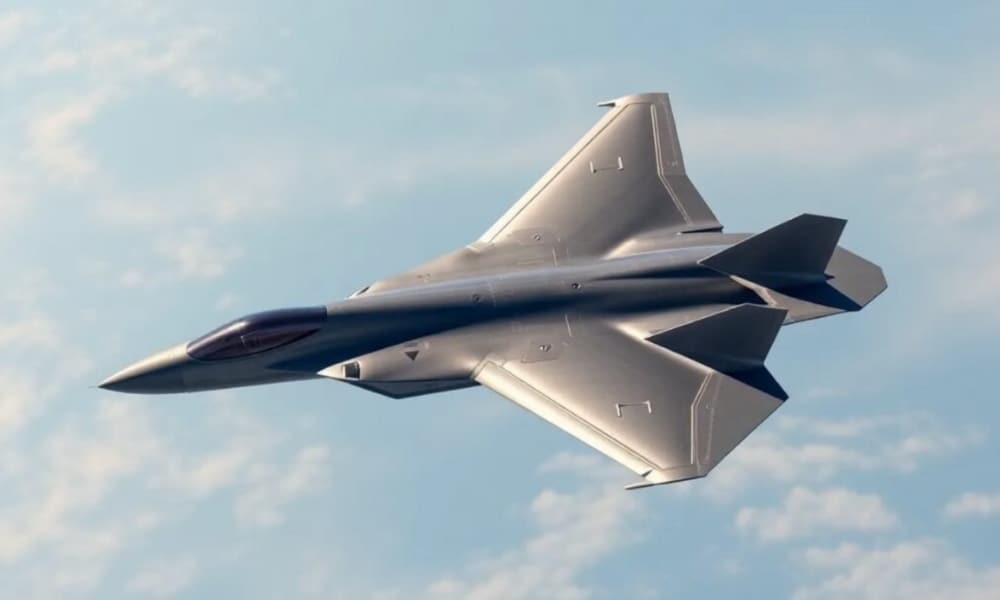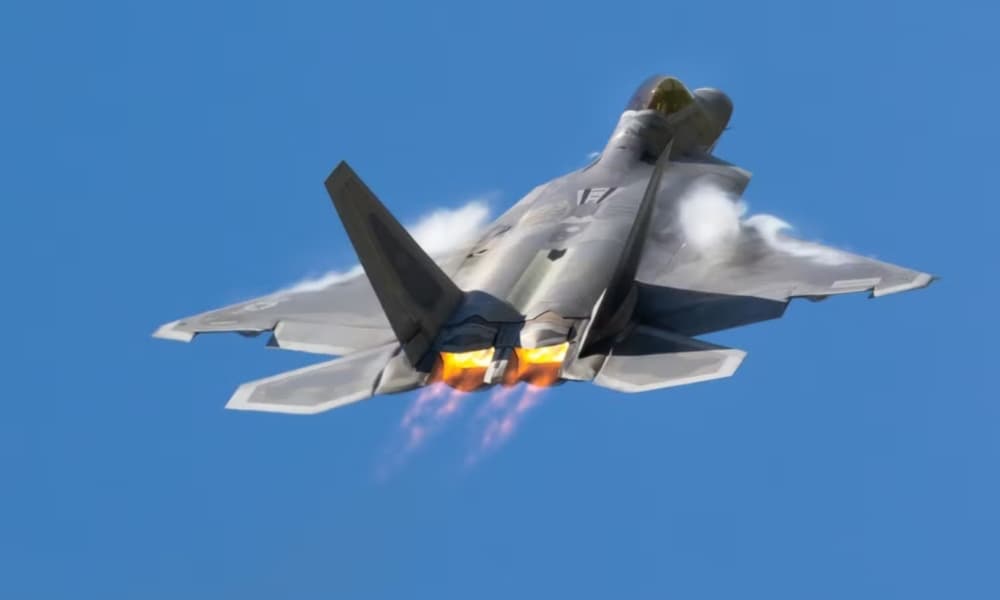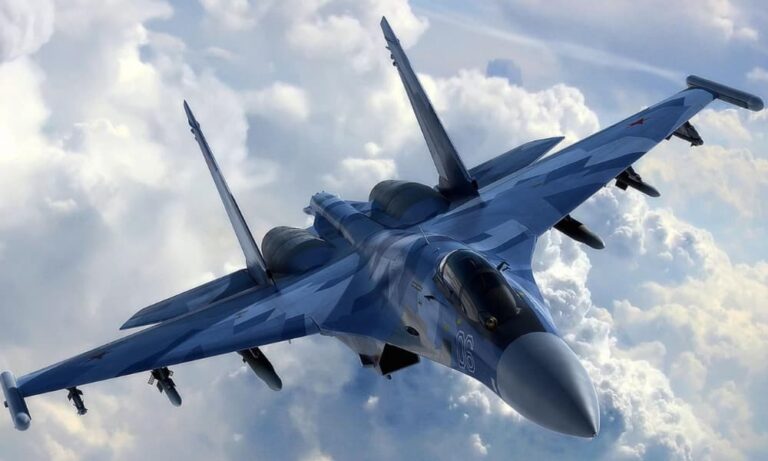Fighter jets scream across the sky at breathtaking speeds. But how fast do they actually fly during combat? Let’s break down the real numbers.
What is the Average Speed of Fighter Jet?
The average fighter jet speed ranges from 1,500 to 1,900 mph (2,400 to 3,050 km/h). This equals Mach 2.0 to Mach 2.5.
But here’s what pilots won’t tell you: Fighters rarely fly at maximum speed during actual combat.
Real combat speeds:
- Cruise speed: 621 mph (1,000 km/h) – Mach 0.9
- Combat maneuvering: 460-620 mph (740-1,000 km/h) – Mach 0.7-0.95
- Maximum speed: 1,500-1,900 mph (requires afterburners, only sustainable for 5-15 minutes)
Understanding Fighter Jet Speed Measurements
What is Mach Number?
Mach 1 equals the speed of sound: 767 mph (1,235 km/h) at sea level.
Fighter jet speeds fall into these categories:
- Subsonic: Below Mach 1 (under 767 mph)
- Transonic: Mach 0.8-1.2 (614-920 mph)
- Supersonic: Mach 1-5 (767-3,835 mph)
- Hypersonic: Mach 5+ (over 3,835 mph)
Speed Conversion Chart
| Mach Speed | MPH | KM/H | Knots |
| Mach 0.9 | 690 | 1,110 | 600 |
| Mach 1.0 | 767 | 1,235 | 666 |
| Mach 1.5 | 1,150 | 1,850 | 999 |
| Mach 2.0 | 1,534 | 2,470 | 1,333 |
| Mach 2.5 | 1,918 | 3,087 | 1,666 |
| Mach 3.0 | 2,301 | 3,704 | 2,000 |
Why pilots use “miles per minute”: 420 knots equals 7 nautical miles per minute. This makes mental calculations faster during combat.

Average Speed of Fighter Jet in KM/H
Modern fighters reach 2,400-3,050 km/h at maximum speed.
Breakdown by speed type:
- Standard cruise: 1,000 km/h (Mach 0.9)
- Combat maneuvering: 740-1,000 km/h (Mach 0.7-0.95)
- Maximum sprint: 2,400-3,050 km/h (Mach 2.0-2.5)
NATO and international air forces use km/h for coordination. European aircraft specs list speeds in metric measurements.
Average Fighter Jet Speed MPH: Real Performance Data
Modern Fighter Speeds
F-22 Raptor: 1,500 mph (2,414 km/h) – Mach 2.25
- Supercruise capability: Mach 1.8 without afterburners
- Most advanced air superiority fighter
F-16 Fighting Falcon: 1,353 mph (2,178 km/h) – Mach 2.0
- 4,500+ built worldwide
- Optimal cornering velocity: 420 KIAS
F-35 Lightning II: 1,200 mph (1,930 km/h) – Mach 1.6
- Lower speed but superior stealth
- 3,000 deliveries planned
F-15 Eagle: 1,650 mph (2,655 km/h) – Mach 2.5
- 104-0 air combat record (undefeated)
- Twin-engine powerhouse
F/A-18 Super Hornet: 1,190 mph (1,915 km/h) – Mach 1.8
- US Navy primary fighter
- Carrier-based multi-role aircraft
Maximum Speed of Fighter Jet: Top 10 Fastest
1. MiG-25 Foxbat
Maximum speed: Mach 3.2 (2,190 mph / 3,524 km/h)
The MiG-25 holds the record as the fastest operational fighter jet. Soviet engineers built it to intercept the SR-71 Blackbird. Pilots were restricted to Mach 2.8 in operation. Flying faster damaged the engines.
2. MiG-31 Foxhound
Maximum speed: Mach 2.83 (1,864 mph / 3,000 km/h)
This improved MiG-25 successor features advanced radar systems. It remains Russia’s fastest operational fighter. The aircraft serves as an all-weather interceptor.
3. F-15 Eagle
Maximum speed: Mach 2.5 (1,650 mph / 2,655 km/h)
The F-15 maintains a perfect 104-0 air combat record. No F-15 has ever been shot down in air-to-air combat. The twin-engine design provides massive thrust. The latest F-15EX variant continues production today.
4. F-14 Tomcat
Maximum speed: Mach 2.34 (1,544 mph / 2,485 km/h)
Variable-sweep wings gave the F-14 incredible versatility. Pilots reported reaching Mach 2.3 in operational configuration. The US Navy retired the Tomcat. Iran still operates the aircraft.
5. F-22 Raptor
Maximum speed: Mach 2.25 (1,500 mph / 2,414 km/h)
The F-22 combines stealth with speed. It can supercruise at Mach 1.8 without afterburners. This saves fuel while maintaining high speed. Only the US operates this aircraft.
6. F-16 Fighting Falcon
Maximum speed: Mach 2.0 (1,353 mph / 2,178 km/h)
Over 4,500 F-16s have been built. Thirty countries operate this lightweight interceptor. The design prioritizes dogfighting excellence. It remains in production.
7. F-4 Phantom II
Maximum speed: Mach 2.23 (1,470 mph / 2,366 km/h)
The F-4 served as a Cold War workhorse. Turkey, Greece, and Iran still fly this aircraft. It proved itself in combat repeatedly.
8. Su-27 Flanker
Maximum speed: Mach 2.35 (1,550 mph / 2,500 km/h)
This Russian air superiority fighter features supermaneuverability. Multiple variants serve in air forces worldwide. The design emphasizes agility.
9. F/A-18 Super Hornet
Maximum speed: Mach 1.8 (1,190 mph / 1,915 km/h)
The Super Hornet replaced the F-14 Tomcat. It serves as the US Navy’s primary fighter. The design balances speed with carrier operations.
10. F-35 Lightning II
Maximum speed: Mach 1.6 (1,200 mph / 1,930 km/h)
The F-35 flies slower than predecessors. But superior stealth compensates. Advanced sensors provide tactical advantages. Speed alone doesn’t win modern combat.
How Fast Does a Jet Go During Air Combat Maneuvering?
Modern air combat maneuvering happens at 350 to 600 KIAS (403-690 mph or 648-1,110 km/h).
Each aircraft has a specific optimal cornering velocity. This speed gives the greatest rate of turn. Pilots maximize maneuverability at this speed.
Example: Lockheed Martin F-16C Block 50/52
- Cornering velocity: 420 KIAS (483 mph / 778 km/h)
- Pilots maintain this speed when entering a merge
- Provides maximum turning advantage
Why Combat Happens at Subsonic Speeds
Speed vs maneuverability trade-off:
- Faster speed = wider turn radius
- High speed makes overshooting easier
- Lower speeds provide better control
- Tight turns win dogfights
The fastest recorded dogfight reached Mach 1.2. A US F-4 Phantom shot down a MiG-19 over Vietnam. Most dogfights happen well below this speed.
Energy Management in Combat
Fighter combat revolves around energy state. Energy comes in two forms:
Kinetic energy: Speed Potential energy: Altitude
Pilots trade these constantly:
- Dive to gain speed
- Climb to gain altitude
- Maintain optimal energy for weapons employment
A good fighter pilot maneuvers through space efficiently. The goal: gain the best speed and turning performance for the least energy consumed.
Fighter Jet Speed KM/H: Combat Reality
Real Combat Speed Data
Most jet combat takes place at subsonic speeds between Mach 0.7 to 0.95 (537-729 mph or 865-1,173 km/h).
Fighter jets can only reach top speeds for short periods. Afterburners burn fuel 3-5 times faster. Maximum speed lasts 5-15 minutes before fuel runs critically low.
Minimum Controllable Speed
Around 180 knots (207 mph / 333 km/h) is the minimum speed where fighters remain fully controllable.
Below this speed, control surfaces lose effectiveness. The aircraft becomes sluggish. Recovery takes precious seconds.
Interception Mission Speeds
When intercepting slower aircraft like a Cessna (100 knots cruise), fighters must fly circles around them. Speed matching proves impossible. The jet constantly repositions.
Average Speed of Jet Plane: Fighter vs Commercial
Fighter Jets
- Cruise: 621 mph (1,000 km/h)
- Maximum: 1,500-1,900 mph (2,400-3,050 km/h)
- Combat: 460-620 mph (740-1,000 km/h)
Commercial Airliners
- Cruise: 547-575 mph (880-925 km/h) / Mach 0.78-0.85
- Maximum: ~600 mph (965 km/h)
Fighters fly 2-3 times faster than commercial jets. Commercial aircraft prioritize fuel efficiency. Fighters need tactical speed advantage.
Private Jets
- Gulfstream G650: 708 mph (1,140 km/h) – Mach 0.925
- Cessna Citation X: 716 mph (1,152 km/h) – Mach 0.935
Private jets remain subsonic. They’re faster than commercial but slower than fighters.

Why Modern Fighters Are Slower Than Cold War Jets
The 1960s F-4 Phantom reached Mach 2.23. The 2025 F-35 Lightning tops out at Mach 1.6.
Modern fighters sacrifice speed for other capabilities.
Stealth Over Speed
Stealth shaping reduces radar visibility but increases aerodynamic drag, as flat surfaces slow the aircraft. Internal weapons bays add weight and reduce aerodynamics.
The F-35 can’t match the F-4’s speed. But it approaches undetected. Stealth provides greater tactical advantage.
Doctrine Changed
Modern air combat emphasizes beyond visual range (BVR) engagements. Missiles fire 50-100+ miles away. Sensors detect enemies before visual contact. Speed matters less when you shoot first.
“First look, first shot, first kill” defines modern tactics.
Maneuverability Requirements
High speed creates wide turn radiuses. A Mach 2 turn requires four times more space than a Mach 1 turn. Pilots need tighter turns to stay behind opponents.
Former F-35 pilot quote: “Going faster makes you overshoot. Most combat happens subsonic where we have control.”
Missiles Outperform Aircraft
Modern air-to-air missiles fly at Mach 4. No aircraft can outrun them. Missiles pull 40-50 Gs in turns. Pilots max out at 7.5-9 Gs.
The missile always has the speed advantage.
Average Cruising Speed of a Fighter Jet
Fighter jets cruise at Mach 0.9 (621 mph / 1,000 km/h) during standard operations.
This subsonic speed balances:
- Fuel efficiency
- Reasonable transit time
- Engine longevity
- Operational range
Pilots reserve maximum speed for critical situations:
- Engaging threats
- Escaping danger
- Intercept missions
- Emergency response
Speed Limitations: G-Forces and Physics
Human Tolerance Limits
Trained fighter pilots withstand 7.5-9 Gs maximum. The average person blacks out at 2-3 Gs without training.
G-LOC risk: G-force induced Loss of Consciousness occurs when blood drains from the brain. Pilots use the “hic maneuver” (Anti-G Straining Maneuver) to maintain blood pressure.
G-suit technology: The suit inflates during high-G maneuvers. It prevents blood from pooling in the legs.
Heart rate during high-G: 145-185 beats per minute.
Aircraft Structural Limits
Modern fighters withstand 12 Gs structurally. This provides a safety margin above pilot tolerance. Missiles pull 40-50 Gs. They turn tighter than any crewed aircraft.
Speed-Turn Radius Relationship
Physics dictates the turn radius:
- At 500 mph: Turn radius = X
- At 1,000 mph: Turn radius = 4X (double speed = quadruple radius)
- At 1,500 mph: Turn radius = 9X
Tactical reality: Can’t turn sharply at max speed. Overshooting becomes easy. Slower speeds win dogfights.
Average Speed of Modern Fighter Jet: Technology Evolution
World War I (1914-1918)
Wooden biplanes: 135 mph (217 km/h)
World War II (1939-1945)
All-metal monoplanes: 450+ mph (725 km/h)
- P-51 Mustang: 437 mph
- Spitfire: 408 mph
Jet Age (1945-1950s)
First generation jets: F-86 Sabre, MiG-15 Breaking sound barrier while diving
Cold War (1960s-1980s)
Speed race peak: Mach 2-3 capabilities
- MiG-25: Mach 3.2
- “Speed is life” mentality dominated
Modern Era (1990s-Present)
Balanced approach: Mach 1.6-2.5
- Stealth prioritized
- Sensors advanced
- Missiles improved
- Doctrine shifted
Fighter Jet Speed at Different Altitudes
Low Altitude (0-10,000 feet)
Dense air creates maximum drag. The F-22 reaches Mach 1.2 maximum at sea level. Fighters typically fly subsonic for ground attack missions.
Medium Altitude (18,000-30,000 feet)
Optimal for many missions. Balances speed and fuel efficiency. Most combat occurs here.
High Altitude (40,000-50,000+ feet)
Thinner air equals less drag. The F-22 achieves Mach 2.25 at high altitude. The F-15 service ceiling reaches 65,000 feet.
Altitude Speed Comparison
| Altitude | F-22 Max Speed |
| Sea Level | Mach 1.2 (920 mph / 1,480 km/h) |
| 30,000 ft | Mach 1.8 (1,380 mph / 2,220 km/h) |
| 50,000 ft | Mach 2.25 (1,500 mph / 2,414 km/h) |
Compare Average Speeds of Top Fighter Jets Used by US Air Force
Current US Air Force Fighter Speeds
| Aircraft | Max Speed | Cruise Speed | Role |
| F-22 Raptor | Mach 2.25 (1,500 mph) | Mach 1.8 supercruise | Air Superiority |
| F-35A Lightning II | Mach 1.6 (1,200 mph) | Mach 0.9 (621 mph) | Multi-Role |
| F-15EX Eagle II | Mach 2.5 (1,650 mph) | Mach 0.9 (621 mph) | Air Superiority |
| F-16 Fighting Falcon | Mach 2.0 (1,353 mph) | Mach 0.9 (621 mph) | Multi-Role |
Key insight: All aircraft cruise at similar subsonic speeds. Maximum speed varies significantly. Mission role determines speed requirements.
The F-22 stands alone with supercruise capability. It maintains Mach 1.8 without afterburners. This extends range while maintaining high speed.
How Fast Can Fighter Jets Accelerate?
Thrust-to-Weight Ratio
The F-22, F-15, and F-16 all exceed 1:1 thrust-to-weight ratio. This means:
- Can accelerate while climbing vertically
- Defies gravity with pure thrust
- Full afterburner provides massive acceleration
Real Acceleration Data
F-22 Raptor: 0 to Mach 1.5 in approximately 90 seconds with afterburners engaged.
F-15 Eagle: Similar performance to F-22.
Acceleration varies by altitude. Thinner air at high altitude means faster acceleration. Less drag equals quicker speed gain.
Alert Scramble Speed
Quick Reaction Alert (QRA) protocols:
- Engines pre-started on alert status
- Pilots airborne in under 5 minutes
- Rapid intercept of hostile aircraft
- Critical for air defense
Future of Fighter Jet Speed
Hypersonic Development
Research focuses on Mach 5+ capability. The SR-72 “Son of Blackbird” remains conceptual. Unmanned hypersonic vehicles lead development.
China, Russia, and the US compete in hypersonic technology.
Sixth Generation Fighters
Programs in development:
- US NGAD (Next Generation Air Dominance)
- European FCAS (Future Combat Air System)
- UK Tempest program
These programs balance stealth, speed, AI, and sensors. Pure speed isn’t the priority. Integrated capabilities matter more.
Propulsion Advances
Adaptive cycle engines improve fuel efficiency at high speed. Variable bypass ratios provide flexibility. Sustained supersonic flight without afterburners becomes possible.
Future Doctrine
Speed remains valuable for engagement and disengagement. But combined with stealth and sensors. No return to pure speed focus. Multi-domain operations take priority.
FAQs About Fighter Jet Speeds
What is the average speed of a modern military fighter jet?
The average maximum speed of modern military fighter jets is 1,500-1,900 mph (2,400-3,050 km/h) or Mach 2.0-2.5. However, fighters cruise at 621 mph (1,000 km/h) or Mach 0.9 for fuel efficiency.
During actual combat maneuvering, fighters operate at 460-620 mph (740-1,000 km/h) or Mach 0.7-0.95 where maneuverability is prioritized. Maximum speeds require afterburners and can only be sustained for 5-15 minutes.
What is the average speed of a US fighter jet?
US fighter jets have average maximum speeds between 1,200-1,650 mph (1,930-2,655 km/h). The F-22 Raptor reaches Mach 2.25 (1,500 mph), the F-35 Lightning II tops out at Mach 1.6 (1,200 mph), the F-15 Eagle achieves Mach 2.5 (1,650 mph), and the F-16 Fighting Falcon hits Mach 2.0 (1,353 mph). All US fighters cruise at approximately Mach 0.9 (621 mph) during standard operations to conserve fuel.
Average speed of fighter jet in km/h?
In metric measurements, the average fighter jet maximum speed is 2,400-3,050 km/h (Mach 2.0-2.5). Standard cruise speed is 1,000 km/h (Mach 0.9), while combat maneuvering happens at 740-1,000 km/h (Mach 0.7-0.95).
The fastest operational fighter, the MiG-25 Foxbat, reaches 3,524 km/h (Mach 3.2), though operational limits restrict it to Mach 2.8 to prevent engine damage.
Average cruising speed of a fighter jet?
Fighter jets cruise at Mach 0.9 (621 mph / 1,000 km/h) during standard flight operations. This subsonic speed provides the best balance between fuel efficiency, engine longevity, and reasonable transit time.
Pilots reserve maximum speeds (Mach 1.6-2.5) for combat situations, intercept missions, or emergencies. Cruising at maximum speed would exhaust fuel in 5-15 minutes, making sustained high-speed flight impractical.
Average speed of an F-16 fighter jet?
The F-16 Fighting Falcon has a maximum speed of Mach 2.0 (1,353 mph / 2,178 km/h). Its optimal cornering velocity for dogfighting is 420 KIAS (483 mph / 778 km/h), which provides the greatest rate of turn and maximum maneuverability.
The F-16 cruises at Mach 0.9 (621 mph / 1,000 km/h) during standard operations. Over 4,500 F-16s have been built, serving in 30 countries worldwide.
Average flight speed of a fighter jet?
The average flight speed depends on the mission phase. During standard operations, fighter jets cruise at Mach 0.9 (621 mph / 1,000 km/h). During combat maneuvering, they operate at Mach 0.7-0.95 (460-620 mph).
Maximum speeds of Mach 2.0-2.5 (1,500-1,900 mph) are only used briefly during engagements or emergencies. The “average” speed a fighter experiences during a typical mission is closer to the cruise speed than maximum speed.
Which fighter jet models have the highest average speeds?
The MiG-25 Foxbat holds the record at Mach 3.2 (2,190 mph / 3,524 km/h), followed by the MiG-31 Foxhound at Mach 2.83 (1,864 mph / 3,000 km/h). Among Western fighters, the F-15 Eagle tops the list at Mach 2.5 (1,650 mph / 2,655 km/h).
The F-14 Tomcat reached Mach 2.34 (1,544 mph / 2,485 km/h), and the F-22 Raptor achieves Mach 2.25 (1,500 mph / 2,414 km/h) with supercruise capability at Mach 1.8.
Compare average speeds of top fighter jets used by the US Air Force.
The F-15EX Eagle II is fastest at Mach 2.5 (1,650 mph), followed by the F-22 Raptor at Mach 2.25 (1,500 mph), the F-16 Fighting Falcon at Mach 2.0 (1,353 mph), and the F-35A Lightning II at Mach 1.6 (1,200 mph).
Despite these differences, all aircraft cruise at approximately Mach 0.9 (621 mph) during normal operations. The F-22’s unique supercruise capability allows sustained Mach 1.8 flight without afterburners, providing a significant tactical advantage.
Where can I find detailed specs on fighter jet speeds?
Official manufacturer websites (Lockheed Martin, Boeing, Northrop Grumman) publish performance specifications. The US Air Force, Navy, and international military aviation authorities release fact sheets.
Aviation Stack Exchange provides expert discussions from pilots and aviation professionals. Technical publications like Jane’s Defence Weekly offer detailed analysis. Flight manuals and pilot operating handbooks contain precise performance data, though classified versions remain restricted.
Can I purchase models or replicas of fighter jets known for high speed?
Numerous companies produce scale models of famous fighter jets. Tamiya, Revell, and Airfix offer plastic model kits of the F-15, F-16, F-22, and MiG-25. Die-cast models from manufacturers like Hobby Master and Dragon Wings provide pre-built options.
High-end RC models from companies like Freewing and E-flite allow remote-controlled flight. Museum gift shops and specialized aviation retailers stock authentic replicas. Prices range from $20 for basic kits to thousands for detailed RC versions.
Are there commercial flight simulators that replicate fighter jet speeds?
Digital Combat Simulator (DCS) World provides the most realistic fighter jet simulation available to civilians. Microsoft Flight Simulator includes fighter jets with realistic performance modeling.
Professional military training simulators exist but access remains restricted. Sky Combat Ace in Las Vegas offers civilian dogfighting experiences in aerobatic aircraft, though not actual fighter jets. The experience replicates maneuvers and G-forces. Full-motion simulators at flight museums sometimes include fighter jet experiences.
Read Also: Jets That Evade Radar Detection
Conclusion
The average speed of fighter jets ranges from 1,500-1,900 mph (2,400-3,050 km/h) at maximum. But combat reality differs dramatically from specification sheets.
Key takeaways:
Fighters cruise at Mach 0.9 (621 mph) most of the time. Combat happens at Mach 0.7-0.95 (460-620 mph) where maneuverability matters most. Maximum speed requires afterburners and lasts only 5-15 minutes before fuel runs low.
Modern fighters prioritize stealth and sensors over raw speed. The doctrine shifted from speed-focused Cold War tactics to beyond visual range engagements. Missiles fly at Mach 4 and pull 40-50 Gs. Aircraft can’t match these capabilities.
The fastest operational fighter remains the MiG-25 Foxbat at Mach 3.2. But the slowest modern fighter—the F-35 at Mach 1.6 dominates in actual combat. Speed alone doesn’t win fights anymore.
Energy management, situational awareness, and tactical employment matter more than top-line specifications. Fighter pilots focus on optimal cornering velocity. The F-16’s sweet spot of 420 KIAS provides maximum turn rate. This speed wins dogfights, not Mach 2+ sprints.
Fighter jets remain the fastest military aircraft. Human and structural limits constrain performance. G-forces, fuel consumption, and mission requirements determine actual operational speeds. The average speed tells only part of the story. How pilots use that speed determines survival.


